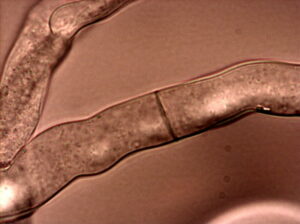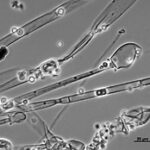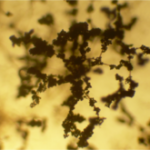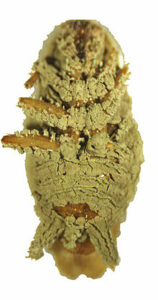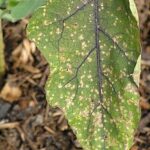Bacteria are remarkably diverse microorganisms that can be classified as both autotrophs and heterotrophs, showcasing their remarkable adaptability and versatility in their nutritional strategies. Understanding the distinction between these two modes of nutrition is crucial for comprehending the essential roles bacteria play in various ecosystems and biogeochemical cycles.
Autotrophic Bacteria: The Self-Sustaining Powerhouses
Autotrophic bacteria are capable of synthesizing their own organic compounds from inorganic sources, such as carbon dioxide (CO2), using energy derived from either sunlight (photoautotrophs) or chemical reactions (chemoautotrophs). These bacteria possess specialized cellular structures and metabolic pathways that enable them to harness energy and convert it into the building blocks of life.
Photoautotrophic Bacteria
Photoautotrophic bacteria, such as Cyanobacteria and Rhodospirillum, are equipped with pigment-containing organelles called thylakoids, which allow them to perform photosynthesis. These bacteria use light energy to drive the reduction of CO2 into organic compounds, similar to the process observed in plants. Cyanobacteria, also known as “blue-green algae,” are particularly noteworthy as they were among the earliest life forms on Earth and played a crucial role in the oxygenation of the atmosphere.
| Photoautotrophic Bacteria | Key Characteristics |
|---|---|
| Cyanobacteria | – Perform oxygenic photosynthesis – Contribute significantly to global primary production – Crucial for the oxygenation of the atmosphere |
| Rhodospirillum | – Perform anoxygenic photosynthesis – Utilize light energy to reduce CO2 into organic compounds – Contribute to the carbon cycle in aquatic environments |
Chemoautotrophic Bacteria
Chemoautotrophic bacteria, on the other hand, derive their energy from the oxidation of inorganic compounds, such as hydrogen (H2), hydrogen sulfide (H2S), or ammonia (NH3). These bacteria use the energy released from these chemical reactions to drive the reduction of CO2 into organic compounds, a process known as chemosynthesis. Chemoautotrophs are found in a wide range of environments, including deep-sea hydrothermal vents, volcanic regions, and even within the human gut.
| Chemoautotrophic Bacteria | Key Characteristics |
|---|---|
| Thiobacillus | – Oxidize reduced sulfur compounds (e.g., H2S) to obtain energy – Play a crucial role in the sulfur cycle |
| Nitrosomonas | – Oxidize ammonia (NH3) to nitrite (NO2-) as an energy source – Contribute to the nitrogen cycle |
| Acidithiobacillus | – Obtain energy by oxidizing ferrous iron (Fe2+) to ferric iron (Fe3+) – Thrive in acidic environments, such as acid mine drainage |
The significance of autotrophic bacteria lies in their ability to fix carbon and produce organic matter, which serves as the foundation for various food webs and biogeochemical cycles. These bacteria are essential for maintaining the balance of carbon, nitrogen, sulfur, and other essential elements in the biosphere.
Heterotrophic Bacteria: The Decomposers and Recyclers
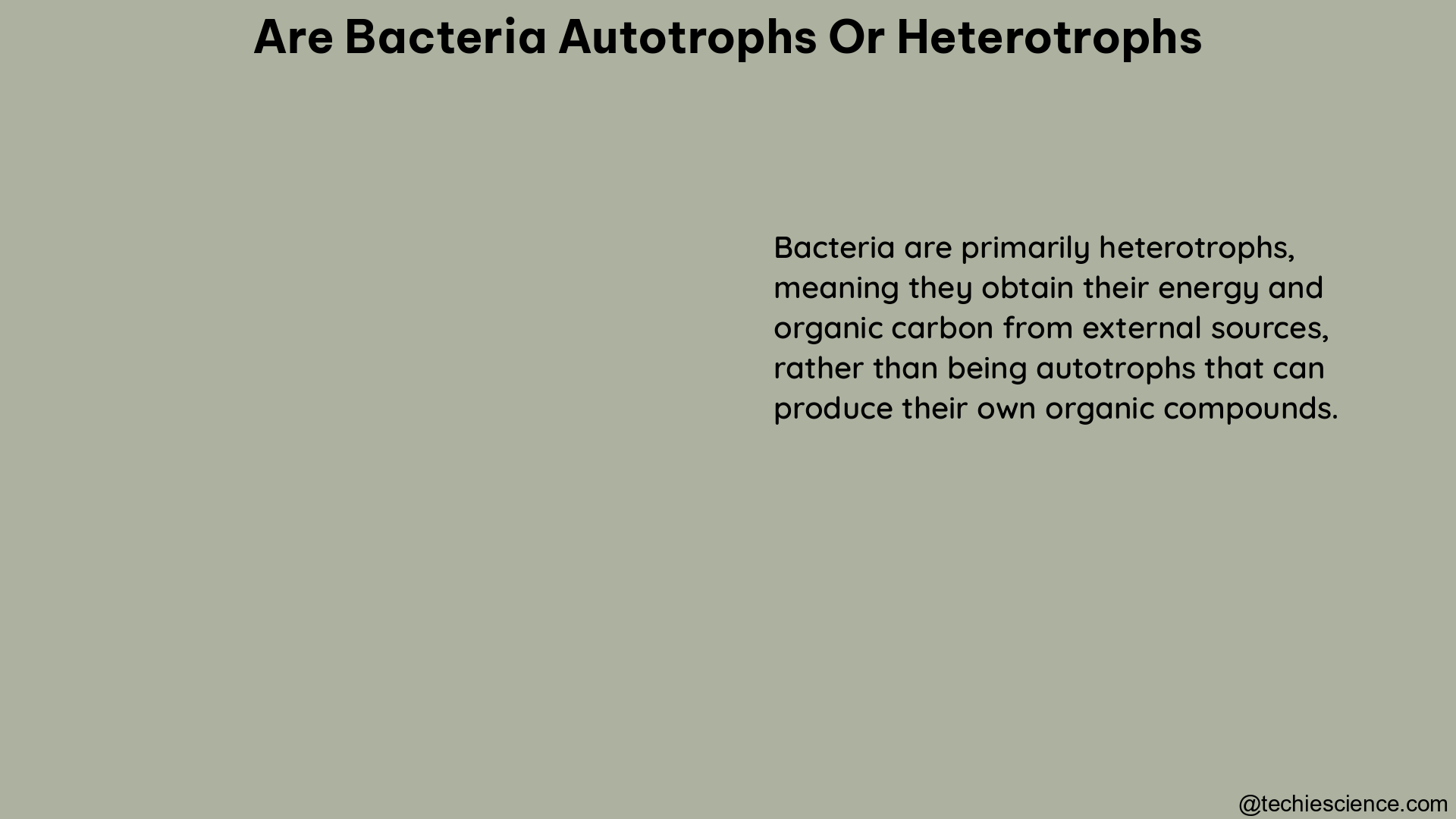
In contrast to autotrophs, heterotrophic bacteria rely on the consumption of organic compounds, such as carbohydrates, lipids, and proteins, as their primary source of energy and carbon. These bacteria play a crucial role in the decomposition of dead organic matter, recycling nutrients, and participating in various biogeochemical cycles.
Decomposition and Nutrient Recycling
Heterotrophic bacteria are the primary drivers of decomposition, breaking down complex organic compounds into simpler molecules that can be readily utilized by other organisms. This process is essential for the recycling of nutrients, such as nitrogen, phosphorus, and sulfur, which are then made available for primary producers (e.g., plants, algae) and other members of the ecosystem.
| Heterotrophic Bacteria | Key Characteristics |
|---|---|
| Escherichia coli | – Commonly found in the human gut – Involved in the digestion and absorption of nutrients |
| Bacillus | – Widely distributed in soil and water – Decompose organic matter, releasing nutrients back into the environment |
| Pseudomonas | – Versatile in their metabolic capabilities – Participate in the degradation of a wide range of organic compounds |
Biogeochemical Cycling
Heterotrophic bacteria play a crucial role in various biogeochemical cycles, such as the carbon, nitrogen, sulfur, and phosphorus cycles. Through their metabolic activities, these bacteria transform and transport essential elements, ensuring the continuous circulation of nutrients within ecosystems.
For example, in the carbon cycle, heterotrophic bacteria are responsible for the decomposition of organic matter, releasing carbon dioxide (CO2) back into the atmosphere or the soil. This CO2 can then be utilized by autotrophic organisms, completing the cycle.
Similarly, in the nitrogen cycle, heterotrophic bacteria are involved in the mineralization of organic nitrogen compounds, converting them into ammonium (NH4+), which can then be nitrified by chemoautotrophic bacteria or assimilated by plants and other organisms.
The versatility and adaptability of heterotrophic bacteria allow them to thrive in a wide range of environments, from the human gut to the deepest ocean trenches, making them indispensable components of various ecosystems.
Quantifying the Contribution of Bacteria to Autotrophic and Heterotrophic Processes
To understand the relative contributions of autotrophic and heterotrophic bacteria to ecosystem processes, researchers often measure various parameters, such as bacterial production, respiration, and biomass.
Bacterial Production
Bacterial production refers to the rate at which bacteria synthesize new biomass, either through autotrophic or heterotrophic pathways. This measurement provides insights into the overall contribution of bacteria to the production of organic matter within an ecosystem.
Bacterial Respiration
Bacterial respiration, the process of converting organic compounds into energy, carbon dioxide, and water, is another important metric. The respiration of all autotrophs and heterotrophs, including bacteria, cannot exceed the input of organic carbon from primary production and allochthonous sources (i.e., organic matter from outside the ecosystem).
Bacterial Biomass
Bacterial biomass, the total amount of bacterial cells present in an ecosystem, can also be used to estimate the relative importance of autotrophic and heterotrophic bacteria. This measurement provides insights into the overall contribution of bacteria to the ecosystem’s trophic structure and energy flow.
By quantifying these parameters, researchers can better understand the role of bacteria in carbon cycling, nutrient recycling, and energy flow within different ecosystems, ultimately informing our understanding of the complex interactions between autotrophic and heterotrophic bacteria.
Conclusion
Bacteria exhibit remarkable diversity in their nutritional strategies, encompassing both autotrophic and heterotrophic modes of existence. This versatility allows them to play crucial roles in global carbon cycling, nutrient recycling, and biogeochemical processes, making them indispensable components of various ecosystems.
Understanding the distinction between autotrophic and heterotrophic bacteria, as well as their respective contributions to ecosystem functions, is essential for advancing our knowledge of microbial ecology and the intricate web of life on our planet.
References:
– Explanation: Are Bacteria Heterotrophic or Autotrophic?
– Autotrophic Bacteria
– Are Bacteria Autotrophic or Heterotrophic?
– Bacterial Production and Respiration in Oligotrophic Ocean Regions: Implications for Carbon Cycling



